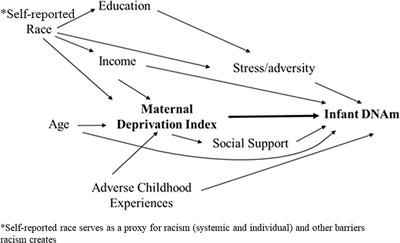|
Medicine by Alexandros G. Sfakianakis,Anapafseos 5 Agios Nikolaos 72100 Crete Greece,00302841026182,00306932607174,alsfakia@gmail.com,
Πληροφορίες
Ετικέτες
Πέμπτη 26 Νοεμβρίου 2020
Associations Between Maternal Community Deprivation and Infant DNA Methylation of the SLC6A4 Gene
Εγγραφή σε:
Σχόλια ανάρτησης (Atom)
Αρχειοθήκη ιστολογίου
-
►
2023
(276)
- ► Φεβρουαρίου (133)
- ► Ιανουαρίου (143)
-
►
2022
(1976)
- ► Δεκεμβρίου (116)
- ► Σεπτεμβρίου (158)
- ► Φεβρουαρίου (165)
- ► Ιανουαρίου (161)
-
►
2021
(3661)
- ► Δεκεμβρίου (161)
- ► Σεπτεμβρίου (274)
- ► Φεβρουαρίου (64)
- ► Ιανουαρίου (368)
-
▼
2020
(4554)
- ► Δεκεμβρίου (400)
-
▼
Νοεμβρίου
(552)
- Ethosuximide induced macroglossia and oropharyngea...
- Effects of allergic rhinitis on the progression an...
- A case series of dermoids in the middle ear.
- Perception of speech stress in children with heari...
- The influence of tonsillectomy on allergic disease...
- Characteristics of the wideband absorbance of acou...
- Clinical practice guidelines on newborn hearing sc...
- Monopolar tonsillotomy versus cold dissection tons...
- Endotracheal metallic stent removal: A novel ABC (...
- The Swedish hearing in noise test for children, HI...
- Novel variants in EDNRB gene in waardenburg syndro...
- Acute isolated sphenoid sinusitis in children: A c...
- A homozygous MPZL2 deletion is associated with non...
- Acute mastoiditis complicated by cerebral venous s...
- Bipolar loop device versus bipolar diathermy for t...
- Self-concept of children and adolescents with coch...
- Airway management protocol for conjoined twins del...
- Feasibility of a hearing screening programme using...
- Nasal dorsum reconstruction after pediatric nasal ...
- Tumor spread through air spaces (STAS): prognostic...
- Recognition of filigree pattern expands the concep...
- TP53 mutations and CDKN2A mutations/deletions are ...
- TFEB rearranged renal cell carcinoma. A clinicopat...
- Clinico-pathologic predictors of patterns of resid...
- Comparing programmed death ligand 1 scores for pre...
- A three-dimensional mechano-electrochemical materi...
- The Prevalence and Causes of Visual Impairment in ...
- Effect of Pomegranate Juice on the Manufacturing P...
- Genetic Testing Distinguishes Multiple Chondroid C...
- Research on Acoustic Emission Characteristics and ...
- An Unusual Complication in Plastic Periodontal Sur...
- Research Progress Review of Preparation and Applic...
- A Novel Cryptococcal Meningitis Therapy: The Combi...
- Quantification of DNA through the NanoDrop Spectro...
- Biochemical Constituents of Phaleria macrocarpa (L...
- The Rise of Transradial Artery Access for Percutan...
- Increased Frequencies of Switched Memory B Cells a...
- The Importance of the Deep Deltoid Ligament Repair...
- Matcha Improves Metabolic Imbalance-Induced Cognit...
- Prophylaxis of Pain and Fractures within Feet in t...
- Glucose Required for Tissue Formation and Its Effe...
- Effects of SMILE Surgery on Intraocular Pressure, ...
- Urgent need to develop evidence-based COVID-19 rec...
- Health State Utilities of Patients with Heart Fail...
- Effect of manual aspiration thrombectomy using lar...
- Lost in Transition: Health Care Experiences of Adu...
- Retrospective Assessment of Risk Factors for Head ...
- Rapid-Cycle Evaluation in an Early Intervention Pr...
- Prediction of Epidemics Trend of COVID-19 in Bangl...
- Hyoscine butylbromide versus acetaminophen for non...
- [Comment] The place for remdesivir in COVID-19 tre...
- Economic Evaluation of Suture Versus Clip Anastomo...
- Professionals guidance about palliative medicine i...
- Hospital end-of-life care: families free-text notes
- Allocation of funding into blast injury-related re...
- Evaluation of glucose-6-phosphate dehydrogenase (G...
- Release of Mafia-crime prisoners during the COVID-...
- Accidental sulfur mustard exposure from explosive ...
- Unusual presentations of cutaneous larva migrans i...
- Sex-Related Differences in Anxious-Depressive and ...
- Microelectrophysiological Studies of the Ratio of ...
- Acoustic and Perceptual Features of the Emotional ...
- Combined Influences of Genetic Factors and Attenti...
- Effect of Intraoperative Goal-Directed Fluid Manag...
- Post-Stent Ballooning during TransCarotid Artery R...
- Pathways to Enable Primary Healthcare Nurses in Pr...
- Associations Between Maternal Community Deprivatio...
- Code-Sharing in Cost-of-Illness Calculations: An A...
- Epidemiology and public health response in early p...
- Serology- and PCR-based cumulative incidence of SA...
- Where has all the influenza gone? The impact of CO...
- Fully-customized distraction assembly for maxillof...
- Routinely collected patient data in neurology rese...
- Vestibular rehabilitation in multiple sclerosis: s...
- A distinct neuromelanin magnetic resonance imaging...
- A laboratory study to assess the formation of effl...
- Combined 3-O-acetylbetulin treatment and carbonic ...
- MicroRNA-188-5p targeting Forkhead Box L1 promotes...
- Imaging features of gastrointestinal toxicity in n...
- Pre-surgical assessment of mediastinal lymph node ...
- The expression and function of immunoglobulin-like...
- Haploidentical related donor compared to HLA-ident...
- Physical activity and exercise in cancer patients ...
- Extracellular vesicles-encapsulated microRNA-10a-5...
- A Multi-institutional Comparative Analysis of Prot...
- Feasibility and safety of exercise training and nu...
- Eradication of T-ALL cells by CD7 targeted univers...
- Starting dose selection and dose escalation for on...
- Risk factors, prognostic factors, and nomograms fo...
- The effect of postmastectomy radiotherapy in node-...
- Analysis of the expression and potential molecular...
- Benefit of dosimetry distribution for patients wit...
- Patients with pretreatment leukoencephalopathy and...
- Short-term mortality risks among patients with non...
- Predictive and prognostic role of tumour-infiltrat...
- Prediction of mortality in metastatic colorectal c...
- Toluidine blue versus frozen section for assessmen...
- Concurrent Dexamethasone Limits the Clinical Benef...
- FDA Approval Summary: Selpercatinib for the Treatm...
- Darolutamide: A Review in Non-Metastatic Castratio...
- ► Σεπτεμβρίου (381)
- ► Φεβρουαρίου (638)
- ► Ιανουαρίου (691)




Δεν υπάρχουν σχόλια:
Δημοσίευση σχολίου